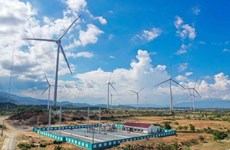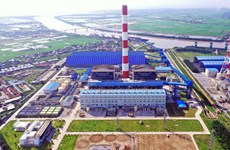Comprehensive investment eases congestion at Tan Son Nhat airport

Hanoi (VNA) - Serious traffic congestion at Tan Son Nhat International Airport could be addressed only with comprehensive investment in terminals, runways, air traffic management and the apron system, according to insiders.
They believed that the strong growth of the aviation sector has caused intense pressure on infrastructure, and Tan Son Nhat airport, the country’s busiest airport, is a typical example.
Comprehensive investment could ‘save’ Tan Son Nhat airport
According to a representative from the Ministry of Planning and Investment, overloading at Tan Son Nhat airport is a vivid illustration for the ‘hot’ growth of the aviation sector. The southern airport has become seriously overloaded both on the ground and in the air, forcing many flights to wait to land.
“The aviation sector is growing explosively while infrastructure still lags behind transportation demand. Besides, airlines can mobilise capital to set up a new airline as well as sign contracts to purchase more airplanes. And overriding priority should be given to ensure flight safety”, the ministry’s representative said.
Chairman of the Airport Corporation of Vietnam (ACV) Lai Xuan Thanh stressed without comprehensive investment, congestion at the airport could not be handled even when construction on terminal No.3 is completed.
He suggested due attention should be paid to the building of the runway and apron systems and related transport infrastructure.
Having the same viewpoint with Thanh, deputy head of the Ministry of Transport’s Planning and Investment Department, Tran Minh Phuong said as a special industry, the aviation sector needs comprehensive investment in terminal, runway, apron and aviation management.
Private firms find it hard to squeeze in building airports
Existing mechanisms and barriers have made it awkward for private enterprises to making investment in airports.
According to Pham Vu Nguyen Tung, Project Manager at the Vietjet Aviation Joint Stock Company, the country has 22 airports to serve a market of 100 million people, and 15 million foreigners. However, large airplanes could not be able to take off and land at Dien Bien Phu airport, an important airport in the northwest region of Vietnam.
“A qualified runway at Dien Bien Phu airport would boost socio-economic development of the large northwestern region. Vietjet wants to invest in the airport, however the firm’s wish has been hampered by many mechanisms and policies”, he said.
Regarding planning work, Tung stated private firms want to join the process which must use state capital. Nevertheless, the fund is not abundant enough to hire excellent experts to make good planning.
Sharing Tung’s viewpoint, Executive Vice Chairman of Bamboo Airways Dang Tat Thang said FLC Group could finish the development of Terminal 3 at Tan Son Nhat Airport within 1-1.5 years if there are favourable mechanisms.
 Existing mechanisms and barriers have made it awkward for private enterprises to making investment in airports.
Existing mechanisms and barriers have made it awkward for private enterprises to making investment in airports. (Photo: VietnamPlus)
Meanwhile, ACV Chairman Lai Xuan Thanh affirmed the State is encouraging the participation of different social resources in building airport infrastructure, describing Van Don International Airport in Quang Ninh province as an outstanding example.
Thanh stressed the social involvement must ensure benefits of both community and investors.
According to Thanh, the State should mobilise investment from various social resources in the whole airport, not just separate components.
“Not all airports across the nation bring back direct benefits. However, the State has to maintain their operation, including local airports which help branch out local socio-economic development but not provide benefit for the airports themselves”, he said.
A representative from the Ministry of Planning and Investment believed that the State’s regulations are encouraging all economic sectors to engage in infrastructure development in general and aviation facilities in particular.
He pointed out private firms’ proposals to develop airport have not been approved due to difficulties in mechanisms.
“Currently, aviation infrastructure is the State’s asset. As it is currently under management of the ACV, the authority needs to spend big on maintenance of the airports. We hope that the investors will continue studying investment opportunities, and have rational recommendation to develop aviation infrastructure in the coming time”, he added./.











